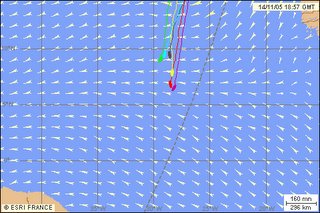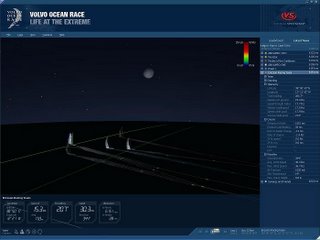And thats just when things are good, when things aren't breaking for against the power of wind and wave even carbon fibre can crumple, and the mere human flung like dolls across cockpit at the mercy of the extreme loads on spars, ropes and sails.
But it is gripping too - to battle against the forces of nature, to use technology, brawn and brain to overcome the elements and competition across the wide oceans to win both trophies and pride. So its great to be able to taste the excitment and thrills while staying in the warm and comfort of home.
The web has proved a natural home for following the far flung fleets. A typical plot is shown below taken from the Transat Jacque Vabres. It shows the lead Open 60s as of 14th November 2005. You can see their direction, track, and route line. This site is better than many as you can overlay the wind direction and strength for the next few days.

This helps you appreciate the race better by seeing the tatics played out in front of you. So Jean and Ellen are both heading nearly due south - why? Well they are entering the doldrums so it could be local conditions - squalls to avoid. But it could also be to get a better wind angle when they emerge from it so they can reach towards Brazil.
But this level of information has been blown away by the absolutely amazing Volvo free software Virtual Spectator. This gives a 3D interactive tool which shows boats sailing under moon and stars, linked into instruments and database of positions.

It's not just good to look at, it really does give a better idea about what is happening. It was clear from VS that Ericsson had had a minor problem because their track paused for about half an hour - just what you'd expect from the "issue with a sail and a halyard" admitted to a day later. And by overlaying the fleet's position, wind direction and tack you can think yourself into the navigator's head as they ponder the big question of the day: when to gybe?
Must be soon.
(*) VMG = Velocity Made Good - how fast you are going in the direction of the destination
No comments:
Post a Comment